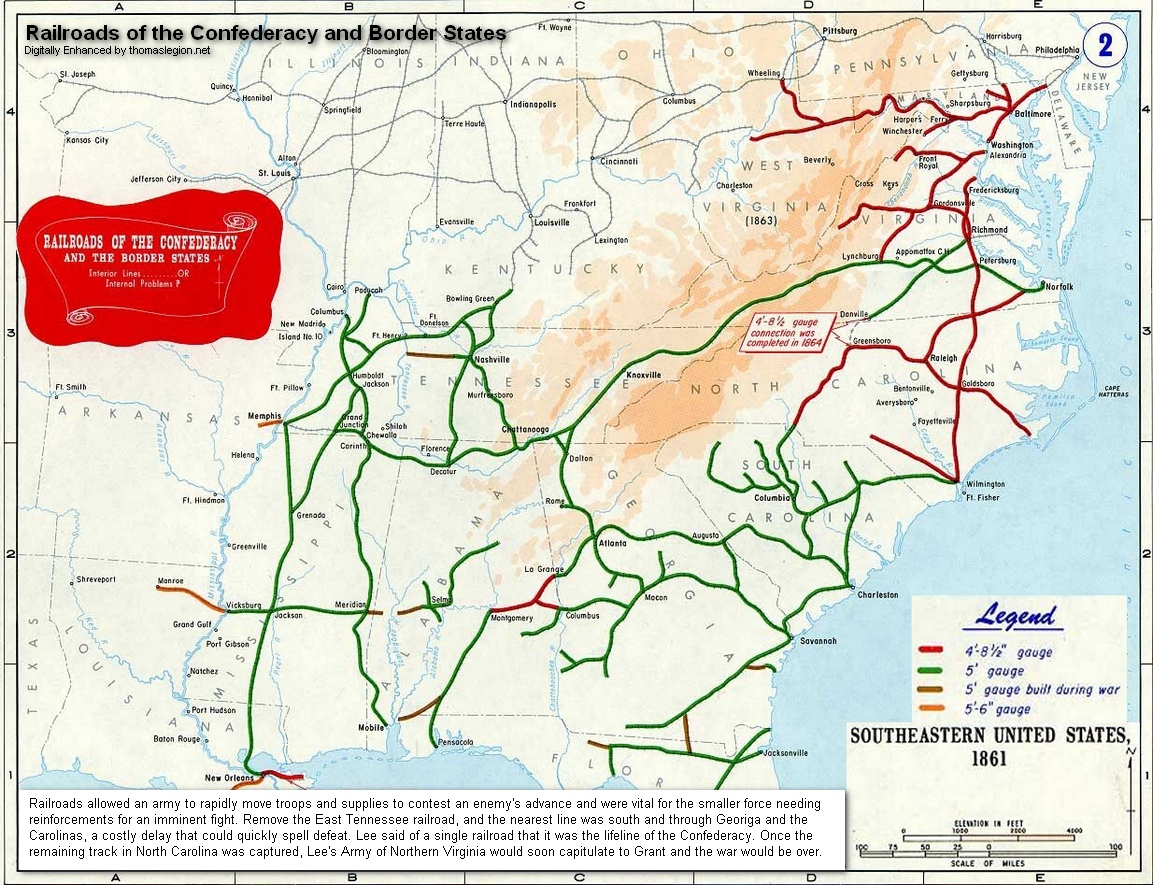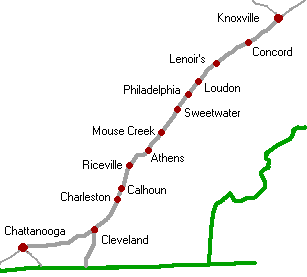|
Tennessee Civil War Railroad History
Confederate Railroads
of East Tennessee & Georgia
East Tennessee & Georgia Railroad
The East Tennessee & Georgia Railroad extended 112 miles from Knoxville to Chattanooga. Chartered in
1848, the original line was completed in 1855, running through Dalton (Georgia) to Chattanooga, but a more direct route between
Cleveland and Chattanooga (the "Cleveland Branch" of 27 miles) was completed in 1858. Construction of the ET&G was
difficult due to the mountainous terrain. Located in eastern Chattanooga, the Missionary Ridge Tunnel (980 feet long)
constitutes an impressive example of the engineering work needed to complete the rail line. Because the
ET&G ran through an area with strong Unionist sympathies, there were several railroad bridge burning episodes on this
line early in the war.
| East Tennessee Civil War Railroads |

|
| East Tennessee Civil War Railroads |
| Tennessee Civil War Railroad Map |

|
| Tennessee Civil War Railroads |
Source: Middle
Tennessee State University
Recommended Reading: Bridge Burners: A True Adventure of East Tennessee Underground Civil War. Description:
When the East Tennessee and Virginia Railway line was completed, dignitaries gathered in celebration as the final spike was
hammered into the last tie in Greene County.
Opening new doors of growth and economic development in the Region, the railroad would become a point of conflict only three
years later. When the Civil War began, the line became a vital link in transporting Confederate troops and supplies into Virginia. The railroad was vulnerable since many hostile Unionists
remained in the region. Continued below...
Confederate authorities were understandably worried about the rail lines and how to protect them. Inevitably
the stage was set and on a cold Friday night, November 8, 1861, the Unionists proceeded with plans to burn the key railroad
bridges of East Tennessee;
President Abraham Lincoln had approved the plan. This thoroughly researched, easy-to-read narrative tells the incredible
true story of the people and events in the ‘insurrection gone wrong’.
Recommended
Reading: Carter's Raid: An Episode of the Civil War in East Tennessee.
Description: During the Civil War, many East Tennesseans remained loyal to the Union. When
the state seceded, it smashed a wedge between the region’s pro-Unionist and Confederate factions. Samuel P. Carter of
Elizabethton, the daring "sailor on horseback" and a naval officer, led the Yankee cavalry in a raid from Kentucky
into his familiar East Tennessee hometown. Continued below...
This strategy was part of a tong-term effort, or grand strategy, by the Federal government to utilize the
loyal East Tennesseans
to destroy the Southern rebellion. The author relates an exciting story of "the first long-distance raid staged by the Union
cavalry" in this chronicle of a significant and often overlooked turning point of the Civil War in Southern
Appalachia.
Recommended Reading:
The Railroads of the Confederacy (400 pages) (The University of North Carolina
Press: April 15, 1998). Description: Originally published
by UNC Press in 1952, The Railroads of the Confederacy tells the story of the first use of railroads on a major scale in a
major war. Robert Black presents a complex and fascinating tale, with the railroads of the American South playing the part
of tragic hero in the Civil War: at first vigorous though immature; then overloaded, driven unmercifully, starved for iron;
and eventually worn out—struggling on to inevitable destruction in the wake of Sherman's army, carrying the Confederacy
down with them. Continued below...
With
maps of all the Confederate railroads and contemporary photographs and facsimiles of such documents as railroad tickets, timetables,
and soldiers' passes, the book will captivate railroad enthusiasts as well as readers interested in the Civil War.
Recommended Reading: War at Every Door: Partisan Politics and Guerrilla Violence in East Tennessee,
1860-1869. Description: One of the most divided regions of the Confederacy, East Tennessee
was the site of fierce Unionist resistance to secession, Confederate rule, and the Southern war effort. It was also the scene
of unrelenting 'irregular,' or guerrilla, warfare between Union and Confederate supporters, a conflict that permanently altered
the region's political, economic, and social landscape. In this study, Noel Fisher examines the military and political struggle
for control of East Tennessee from the secession crisis through the early years of Reconstruction,
focusing particularly on the military and political significance of the region's irregular activity. Continued below...
Fisher portrays
in grim detail the brutality and ruthlessness employed not only by partisan bands but also by Confederate and Union
troops under constant threat of guerrilla attack and government officials frustrated by unstinting dissent. He demonstrates
that, generally, guerrillas were neither the romantic, daring figures of Civil War legend nor mere thieves and murderers,
but rather were ordinary men and women who fought to live under a government of their choice and to drive out those who did
not share their views.
Recommended
Reading: Stealing the General: The Great Locomotive Chase and the First Medal of Honor. Description: "The Great Locomotive Chase
has been the stuff of legend and the darling of Hollywood.
Now we have a solid history of the Andrews Raid. Russell S. Bonds’ stirring account makes clear why the raid failed
and what happened to the raiders."—James M. McPherson, author of Battle Cry of Freedom, winner of the Pulitzer Prize.
Continued below...
On April 12,
1862 -- one year to the day after Confederate guns opened on Fort Sumter -- a tall, mysterious smuggler and self-appointed
Union spy named James J. Andrews and nineteen infantry volunteers infiltrated north Georgia and stole a steam engine referred
to as the General. Racing northward at speeds approaching sixty miles an hour,
cutting telegraph lines and destroying track along the way, Andrews planned to open East Tennessee to the Union army, cutting
off men and materiel from the Confederate forces in Virginia. If they succeeded, Andrews and his raiders could change the
course of the war. But the General’s young conductor, William A. Fuller, chased the stolen train first on foot, then
by handcar, and finally aboard another engine, the Texas.
He pursued the General until, running out of wood and water, Andrews and his men abandoned the doomed locomotive, ending the
adventure that would soon be famous as The Great Locomotive Chase, but not the ordeal of the soldiers involved. In the days
that followed, the "engine thieves" were hunted down and captured. Eight were tried and executed as spies, including Andrews.
Eight others made a daring escape to freedom, including two assisted by a network of slaves and Union sympathizers. For their
actions, before a personal audience with President Abraham Lincoln, six of the raiders became the first men in American history
to be awarded the Medal of Honor -- the nation's highest decoration for gallantry. Americans north and south, both at the
time and ever since, have been astounded and fascinated by this daring raid. Until now, there has not been a complete history
of the entire episode and the fates of all those involved. Based on eyewitness accounts, as well as correspondence, diaries,
military records, newspaper reports, deposition testimony and other primary sources, Stealing the General: The Great Locomotive
Chase and the First Medal of Honor by Russell S. Bonds is a blend of meticulous research and compelling narrative that is
destined to become the definitive history of "the boldest adventure of the war."
Tennessee Civil War Railroads Battles Map History, Battle Railroad
Bridges Tunnels, Photograph Pictures Maps Details Confederate Bridge Burners Facts Rail lines, Tracks, Mountains, Valleys,
Trestles
|

